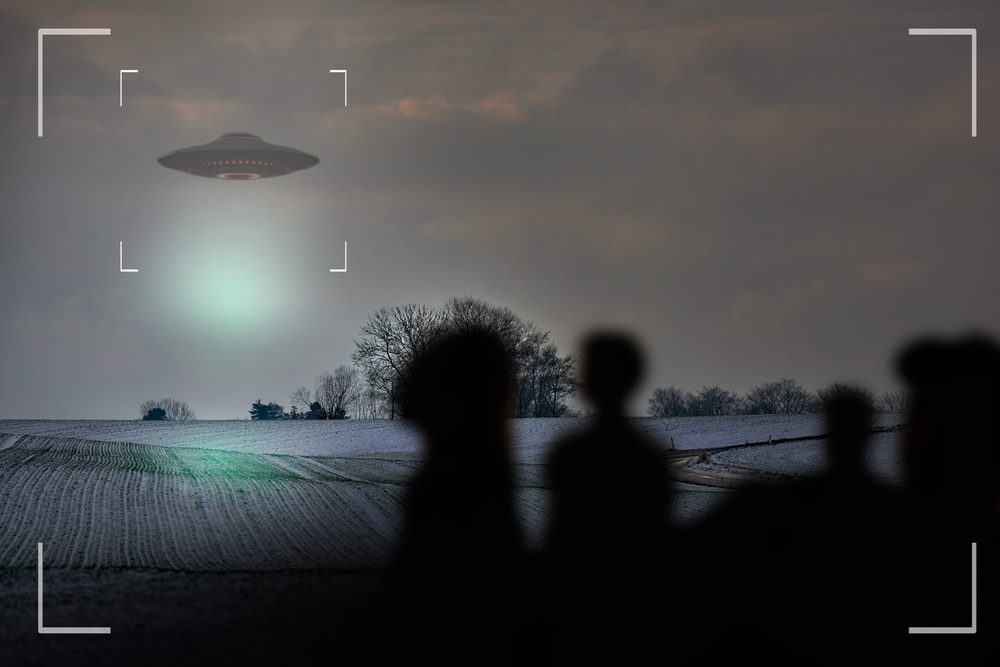
UFOs Are Swarming U.S. Military Zones—And One Just Crashed Into a Fighter Jet

In an incident that feels lifted from the script of The X-Files rather than a routine Air Force report, an F-16 fighter jet flying over Arizona recently collided with an unidentified aerial object during a training mission. Officials later described the intruder as an “orange-white uncrewed aerial system.” The object struck the jet’s canopy mid-flight, creating one of the most tangible and alarming UAP (unidentified aerial phenomena) encounters documented so far. Yet this is not an isolated case. It joins a growing catalog of hundreds of mysterious aerial incidents reported across U.S. restricted airspace in recent years.
From Fringe Topic to National Priority
Once confined to the margins of conspiracy theories and late-night radio shows, UFOs—now labeled more neutrally as UAPs—have shifted into the realm of legitimate national security concerns. Military aviators are reporting strange, often high-speed objects moving in ways no known drone or aircraft can match. Government task forces are actively reviewing hundreds of cases. Lawmakers, too, are increasingly demanding transparency and swift responses. What was once mocked as pseudoscience has now become an operational and political reality.
A Surge of Encounters Over Military Zones
In restricted military zones—especially in the American Southwest—the number of aerial anomalies has surged. Between May 2023 and June 2024, U.S. authorities recorded 757 UAP sightings. Only 49 were definitively resolved, leaving hundreds unexplained.
The encounters vary widely. Some are logged as drones or commercial unmanned aerial systems. Others defy classification altogether. Pilots have described metallic spheres moving in coordinated clusters, glowing objects hovering at commercial altitudes, and UAS-like shapes darting at velocities far beyond typical drone limits. One particularly striking account described eight silver objects flying in tight formation at 20,000 feet—an altitude and speed far exceeding the capabilities of consumer-grade drones, which generally cannot climb above 500 feet or exceed 52 mph.
The Arizona midair collision in January underscored just how serious the situation has become. The object slammed into the canopy of an F-16 Viper, raising alarms not only about the mystery of its origin but also about the risk such intrusions pose to aviation safety and military readiness. Incredibly, it was just one of four separate UAP encounters recorded on that same day.
Beyond Known Technology
While some reports can reasonably be explained by cartel-operated surveillance drones, many cannot. Pilots continue to log encounters with objects that surpass the limits of known commercial or military technologies. These are not rogue hobbyist drones straying into restricted airspace. They are performing maneuvers, holding altitudes, and maintaining speeds that exceed anything publicly known to exist.
For example, pilots have documented craft flying at Mach 0.75—roughly 500 mph—at 33,000 feet. In March 2021, two F-35 pilots reported a “large white UAS” hovering motionless at 24,000 feet, a feat impossible for known tactical drones, which require constant propulsion to stay airborne. In another case, a glowing blue-green object was observed at 36,000 feet, an altitude typically reserved for passenger jets. Such anomalies strongly suggest the presence of either experimental aerospace technology or entirely unknown systems.
Former Pentagon officials caution against easy explanations. While organized crime networks have indeed advanced their drone capabilities, those machines do not account for objects capable of sustained high-speed flight, precision formations, or vanishing abruptly from both radar and visual confirmation.
Escalating Risks to Security and Safety
Perhaps the most troubling feature of these UAP encounters is where they occur: directly within restricted U.S. military zones. These are not sightings in remote civilian areas. They are happening in training exercises, defense corridors, and mission-critical airspace.
The midair collision in Arizona demonstrated the danger vividly. Striking a canopy mid-flight could have easily resulted in catastrophe. Pilots are now not only tasked with executing their missions but also with spotting, tracking, and reporting unidentified objects—a divided attention that could prove disastrous in combat scenarios.
Luis Elizondo, who led the Pentagon’s Advanced Aerospace Threat Identification Program (AATIP), has warned that such incidents occur “constantly,” particularly in areas near the Mexico border. The inability to identify or neutralize these intrusions in real time raises troubling questions about sovereignty and readiness.
Inside the Government’s Struggle to Respond
The Pentagon’s creation of the Unidentified Aerial Phenomena Task Force in 2020—later expanded into the All-domain Anomaly Resolution Office (AARO)—marked a formal acknowledgment of the issue. Yet progress remains slow. Of the 757 cases logged between May 2023 and June 2024, most remain unresolved, reflecting both the complexity of the incidents and the limitations of current investigative frameworks.
Part of the challenge lies in the diversity of data. Some UAPs are visually confirmed by pilots; others are detected on radar but vanish before investigation is possible. Without physical evidence such as debris or recovered craft, conclusions remain speculative. Political and legal sensitivities further complicate matters, particularly when incidents occur near domestic borders or involve classified military operations.
Nonetheless, the government has begun increasing collaboration with agencies such as the FAA and the Department of Homeland Security, signaling a shift toward a more systematic and interagency approach. This emerging framework hints at recognition that UAPs are not isolated curiosities but part of a larger pattern requiring serious, coordinated attention.
From Spectacle to Strategy
The narrative surrounding UAPs has evolved dramatically. No longer relegated to speculation about extraterrestrial visitors, the focus has shifted to aviation safety, aerospace innovation, and national defense. The fact that an uncrewed aerial system physically collided with an F-16 jet is proof that the threat is not theoretical.
Experts across sectors warn that ignoring these encounters is not an option. Whether they represent advanced surveillance tools, experimental aircraft, or phenomena we cannot yet explain, their persistent intrusion into restricted airspace demands urgent analysis and clear policy responses.
Just as transparency has improved resilience in fields like cybersecurity and biothreat response, public awareness may help drive more robust frameworks for aerospace monitoring. The U.S. now faces a choice: dismiss these incidents as unsolvable mysteries, or confront them with the seriousness they warrant.
As the skies grow more crowded and the unknowns more pressing, one fact has become undeniable: UAPs are no longer a fringe issue. They are a matter of immediate national priority—and the time to act is now.
News in the same category


X-rays Reveal Hundreds of Golden Threads Inside a Patient with Severe Knee Pain — Here’s the Reason Why

Blind Man Can Now See Through His Tooth After Losing Sight 20 Years Ago – He Explains How It Works

Harvard expert issues chilling warning that strange object heading towards Earth may be a ‘mothership'

Nvidia's futuristic 'robot brain' officially goes on sale to the public for insane price

Emotional Starbucks Employee Reaction Over Long-Hour Shift Sparks Debate

Shocking Discovery at Her Son’s Bed Leaves Mom Terrified

CRISPR Breakthrough: Scientists Achieve Complete HIV Eradication in Lab Cells

Northern lights alert : the best displays in years could be coming

The Science Behind the Blood Moon: How Earth’s Shadow Creates the Red Glow

Germany’s Suitcase-Sized Turbine Powers 12 Homes from a Small Stream

First PlayStation 6 game could've just been revealed and people aren't impressed

Terrifying moment woman is taunted by stranger 'watching her' through Ring doorbell sparks alarm bells for others

Why You Should Toss a Water Bottle Under Your Hotel Bed

Remembering Aleksander Doba, Who Kayaked Across Atlantic

10 Breathtaking Frozen Lakes, Oceans And Ponds, That Look Like Art

The World’s Largest Edible Mushroom Lives in Symbiosis with Termites and That’s Why It Grows So Huge

Calla Lily Valley Near Big Sur, California

Starlings Obscure the Sky Over Rome: A Dystopian Viral Photo
News Post

Game-changing 'hidden' features in iOS 26 update you've probably missed

X-rays Reveal Hundreds of Golden Threads Inside a Patient with Severe Knee Pain — Here’s the Reason Why

Blind Man Can Now See Through His Tooth After Losing Sight 20 Years Ago – He Explains How It Works

Harvard expert issues chilling warning that strange object heading towards Earth may be a ‘mothership'

Nvidia's futuristic 'robot brain' officially goes on sale to the public for insane price

These 4 places are "bacteria nests" in the rice cooker, need to be cleaned every month

🌿 Wash Your Hair with This Herb and Watch Baby Hairs Grow Back Fast — Say Goodbye to Hair Fall

🪵 Don't Wash Moldy Wooden Cutting Boards with Soap—Try This 5-Minute Natural Cleaning Hack Instead

🌾 Ginger and Rice Water Hair Treatment: A Natural Secret for Fast Growth, Thicker, Shinier Hair

Colgate Toothpaste for Face Whitening: The Secret Combo of Tomato and Colgate 🍅✨

Emotional Starbucks Employee Reaction Over Long-Hour Shift Sparks Debate

Shocking Discovery at Her Son’s Bed Leaves Mom Terrified

If You Have These Two ‘Dimples’ on Your Lower Back, This is What They Mean

How My Nana’s Baking Soda Skincare Routine Became My Favorite Beauty Secret

Popular Drink Could Be Permanently Staining Your Teeth Yellow, Experts Say

Powerful Natural Remedies for Ear Infections That You Can Try at Home

CRISPR Breakthrough: Scientists Achieve Complete HIV Eradication in Lab Cells

Northern lights alert : the best displays in years could be coming

The Science Behind the Blood Moon: How Earth’s Shadow Creates the Red Glow
